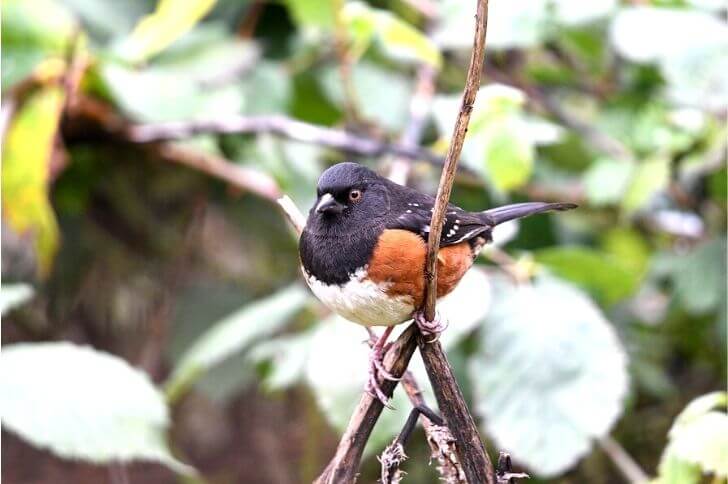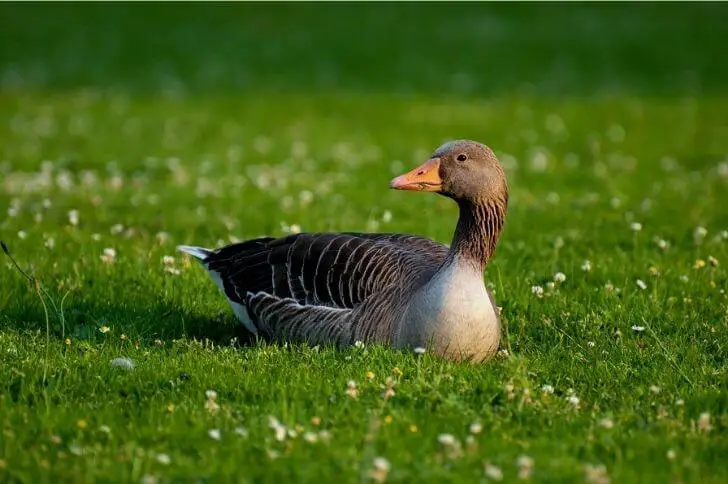Black birds with white beaks are a fascinating sight. These birds are often seen as unusual and they definitely stand out from the rest. The reason these birds are so interesting is because their coloration is so different from the majority of birds.
The white beaks of some black birds have caused a stir among birdwatchers. Some scientists believe that the white beaks may be a result of genetic mutations. Others believe that they may be the result of selective breeding by humans.
Below we’ll explore the plumage, calls, and habitats of some white beaked birds starting with large birds like the American coot to medium-sized birds like the yellow rumped cacique. Any of the birds below will be a great addition to your bird watching list.
List of Black Birds with White Beaks
1. American coot

Size:
How big are American coots? Larger than a blue jay but smaller than the American crow. American coots are 15 – 16.9 inches with a wingspan of up to 25 inches. A mature male coot can weigh about 1.9 lb while females are about 1.4 lbs. Coot chicks are smaller in size.
Plumage:
American coot is an all black bird. However the feet are yellow-green and they have a bright white bill. Eyes are stunning red. Immature coots are grayish.
Habitat & facts:
The American coot or the Fulica americana is a large water bird that can be found in both the Pacific and Atlantic coastal regions of North America. These birds are common in both fresh and saltwater habitats, and can often be seen wading in shallow water or swimming on the surface.
Unlike other water birds they do not have webbed feet. American coots are omnivorous birds, and they feed on a variety of items such as insects, aquatic plants, small fish, and amphibians. They are known to be aggressive towards other birds and animals when defending their territory or food sources.
2. Pied butcherbird
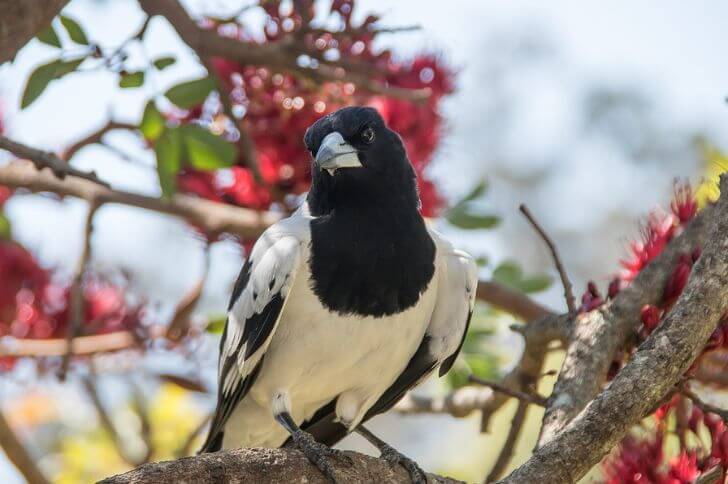
Size:
How long are pied butcherbirds? Like other birds in their family, butcherbirds average 11 to 12.5 inches in length. They boast a 20-inch wingspan and it’s worth noting they have long wings.
Plumage:
Very distinctive. Pied butcherbirds are black and white with a white black-tipped bill. Immature birds have a grayish head and belly with blackish wings.
Habitat & facts:
The pied butcherbird is a passerine bird of the family Artamidae. It is found in open country and woodland in Australia.
This black bird with white beak is territorial and aggressive, often chasing away other birds larger than itself. It feeds mainly on insects, but will also take small lizards, frogs and rodents.
When do pied butcherbirds breed? Nesting season starts in July and lasts through to December. The clutch has two to five eggs and young ones hatch after 21 days.
3. Magpie lark
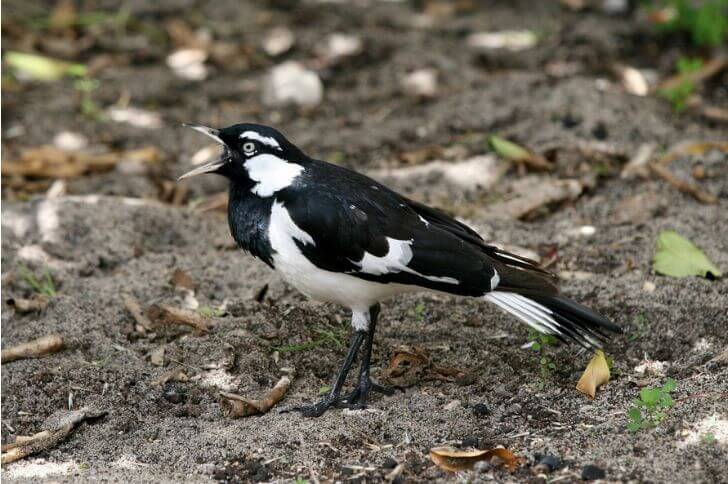
Size:
Magpie larks are small birds, measuring about 9-12 inches in length, slightly larger than the common blackbird. How big is this bird? When you spot these birds, you’ll notice the slight difference between the sexes.
Males are larger than female magpie larks weighing up to 4.2 oz while females are 3.3 oz.
Plumage:
These white beaked birds are a beautiful black and white; black back, white wings and belly, pale eyes and of course the white bill.
Habitat & facts:
Magpie larks are a passerine bird that is endemic to Australia. It is found across the country, except for in the very dry deserts of central Australia. It is a common bird and can be found in many different habitats, including open forests, woodlands, scrublands, and farmland.
The song of the magpie lark is a series of high-pitched notes that is sung by pairs; duet. They make nests out of plant material and grass. Both parents incubate eggs for about eighteen days.
4. Turkey vulture
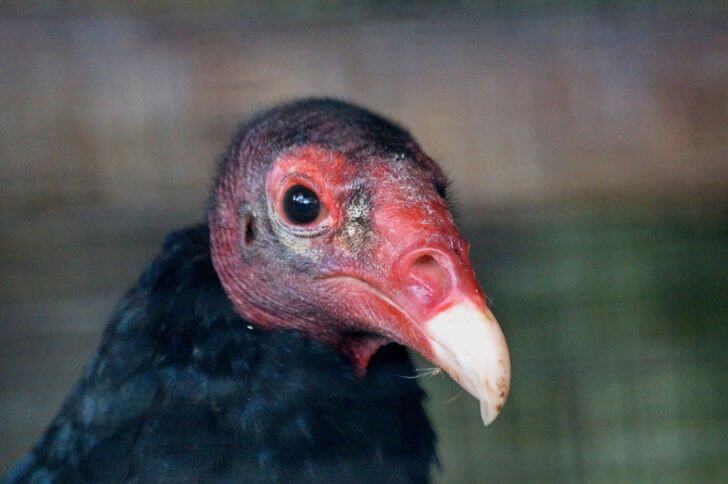
Size:
Large black birds. Turkey vultures are large raptor birds that range 25 – 32 inches (64 – 81 cm) and can weigh 70.5 oz. They are slightly smaller than the bald eagle, making them easy to spot.
Plumage:
Turkey vultures have very distinctive features. Be on the look for a large black-brownish bird with a long tail. It has a featherless head, with the bare skin giving it a red look. Its bill is red and white. Juveniles have an ashy colored head.
Habitat & facts:
The turkey vulture is a type of bird that can be found throughout North America. This particular vulture is known for its bald head and red neck, which helps it to stay cool in the summer heat.
Turkey vultures are scavengers, meaning they eat the remains of dead animals. They are an important part of the ecosystem, as they help to clean up the environment by getting rid of carcasses.
They can often be seen circling in the sky above roadsides and other areas where animals have died.
5. White-billed crow
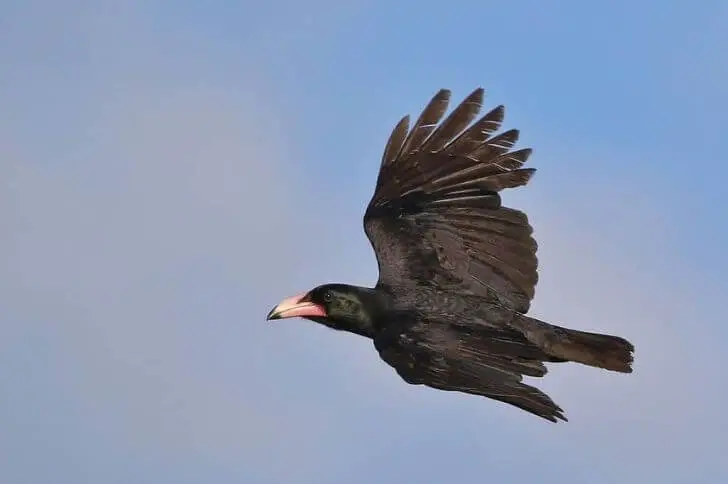
source: world.snapshot.hub
Size:
How long is the white-billed crow? Larger than brown headed cowbirds, white-billed crows measure up to 16 inches in length. They are the same size as the American crow.
Plumage:
Like most members of the crow family, this species is all black bird with a white bill. Also the bill is slightly curved. Feet and legs are black.
Habitat & facts:
Found in the Solomon Islands, the white-billed crow is omnivorous and feeds on a variety of food items, including insects, small mammals, birds and eggs. It is a social bird and typically lives in small groups. The white-billed crow can be found in a variety of habitats, including forest edges, savannas, and city parks.
Its notes include very sharp “ao-ao”.
6. White-billed buffalo weaver

source: faraazadool
Size:
Dark and long-tailed, white-billed buffalo weavers are 9-inch birds from the ploceidae family which also includes the sociable weaver and widowbirds.
Plumage:
Big and bulky. White-billed buffalo weavers are black with white spots on their sides. Males have white bills while the females are black-billed. Their calls include harsh “sjet”.
Habitat & facts:
The white-billed buffalo weaver is a common species of bird found in open habitats across sub-Saharan Africa. These weavers build large communal nests up to 6 ft across, typically using thorny branches and twigs from trees or bushes. The nests are used for breeding and roosting, and can accommodate several hundred birds.
7. White-billed starling
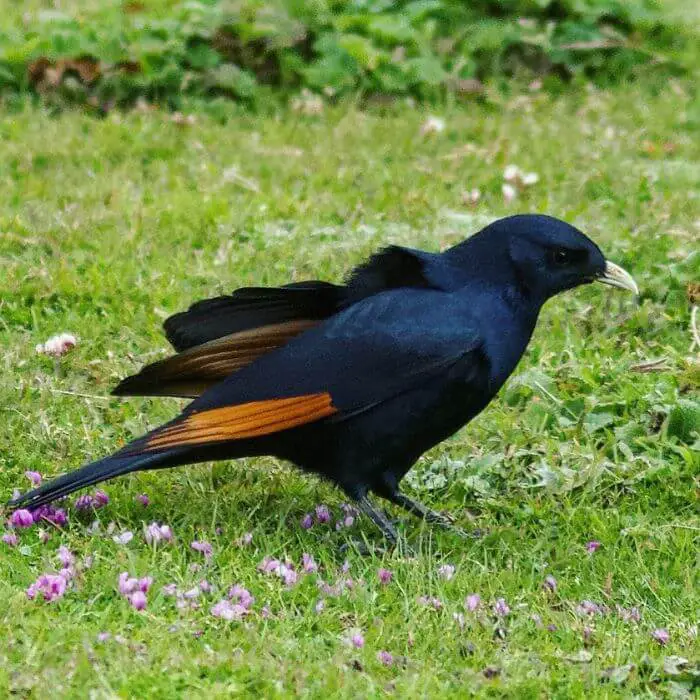
source: mortenlisse
Size:
Closely related to European starlings, white-billed starlings are another type of black birds with white beaks. Like their cousins, they are about 10 inches long and weigh about 5 oz.
Plumage:
White-billed starlings are sexually dimorphic. Like other birds on this list, male are black with glossy feathers. The female starling has a gray head. Both sexes have white bills. In flight, you’ll notice the brown wing patches.
Habitat & facts:
Favoring stiff cliffs, white-billed starlings are passerine birds found in parts of Africa. It’s from the starling family. They feed on insects, spiders, worms, berries, and seeds.
8. Rose-breasted Grosbeak
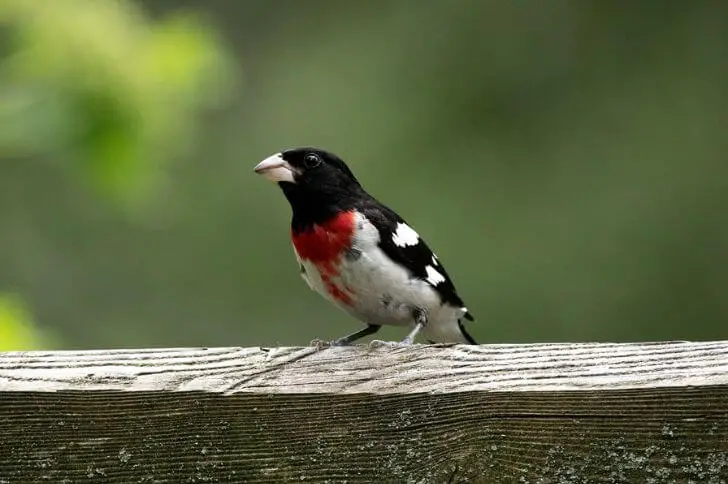
Size:
Measuring up to 8.7 inches, the rose-breasted grosbeak is a common bird in the Southeastern United States. An adult can weigh about 2 oz with a 11-13-inch wingspan. Larger than the American goldfinch and smaller than the blue jay.
Plumage:
Females and males have different color patterns. Males have a dark head and back with white patches on their wings, red breasts, and white bellies. Pay extra attention to their white bills and dark eyes.
Females are a streaked brown with a white eyebrow. Both sexes have short triangular bills, square tails and are broad-chested.
Habitat & facts:
When do rose-breasted grosbeaks breed? Their breeding season starts in May through July. Most pairs typically incubate 4 eggs. For about two weeks, both parents take turns incubating the eggs. Young birds leave the nests after about 9 – 12 days. The male builds a cup-shaped nest out of twigs and grasses, which he then lines with feathers.
Rose-breasted grosbeaks are omnivore, eating a variety of insects, fruits, and seeds. Where can you find these birds? In the orchard, deciduous woods and mixed woods.
9. Crested oropendola

source: creationsbydiane
Size:
How big are crested oropendola? On average, adults oropendolas can measure 14 – 18.5 inches (37 – 47 cm) and weigh 5.5-10 oz.
Plumage:
Unlike most black birds with white beaks, crested oropendolas are very easy to spot. Their bodies are black but take a closer look at their undertail, it’s reddish-brown. Also their stunning blue eyes, thick triangular bill, and yellowtail are very distinctive features.
Habitat & facts:
This white beaked bird ranges from southern Mexico to northern Argentina and Brazil. The male and female are similar in appearance, but the male is slightly larger.
It is a social bird, typically found in small flocks of 5-10 birds. It feeds on insects, fruit, and nectar. The Crested Oropendola builds a large hanging nest of sticks high in a tree. How long do crested oropendolas live? Up to 20 years.
10. Solitary cacique

source: wiltravelphotos
Size:
Found in tropical Americas, the solitary cacique is a unique bird with white beak. Males are larger, about 10.6 inches while females are about 9 inches.
Plumage:
Solitary caciques are all black except for the creamy white triangular bill. Like the common grackle this bird also has a long tail and dark eyes.
Habitat & facts:
Solitary caciques are members of the family Icteridae. They inhabit open gallery forests and flooded areas of the Amazon, where it feeds on spiders, fruits, and seeds. It is a shy bird which usually stays hidden in the trees, but it can also be quite aggressive towards other birds.
The male sings a clear song from an exposed perch to defend his territory. It builds a cup-shaped nest from thin twigs lined with grass or leaves.
11. Red-rumped cacique

source: gabrielboralideabreu
Size:
A relative of the solitary caciques, red-rumped caciques males are 11.4 inches while female birds are smaller about 9.8 inches. These birds are slightly larger than other members of their family.
Plumage:
Like their cousins, they are all black. Why are they called red-rumped caciques? Take note of the red plumage on their back close to the tail. You can easily see this patch when the bird spreads its wings. Bills are creamy white in color.
Habitat & facts:
The red-rumped cacique is a passerine bird in the New World family Icteridae. It breeds from Panama to Bolivia and Brazil, and also in Trinidad. This species is found in tropical swamp forests and moist lowland forests. The nest is a deep cup of sticks lined with softer material, built low in a tree. 3-4 slightly spotted whitish eggs are incubated for 14 days to hatching, with a further 16–17 days to fledging.
12. Black falcon

source: downtownraptors
Size:
Impressive and aggressive. Black falcons are large birds with white beaks. An adult is 18 – 22 inches (45 – 56 cm) with an average wingspan of 37.4-45.3 inches.
Plumage:
Sooty black overall, young are darker than adult black falcons. The coloration is uniform. Bills base is whitish-gray and black tipped, and their talons are black.
Habitat & facts:
A resident breeder in Australia, the Black Falcon is a medium-sized raptor and a member of the genus Falco. It prefers open areas where it can easily hunt for small mammals, carrion, and birds such as common starlings.
When does the black falcon breed? This bird nests in trees, making a platform of sticks. Breeding season begins in May and lasts up to November. 3-4 eggs are laid, and incubated for about 35 days.
How long do black falcons live? Up to 20 years.
13. Black hornbill
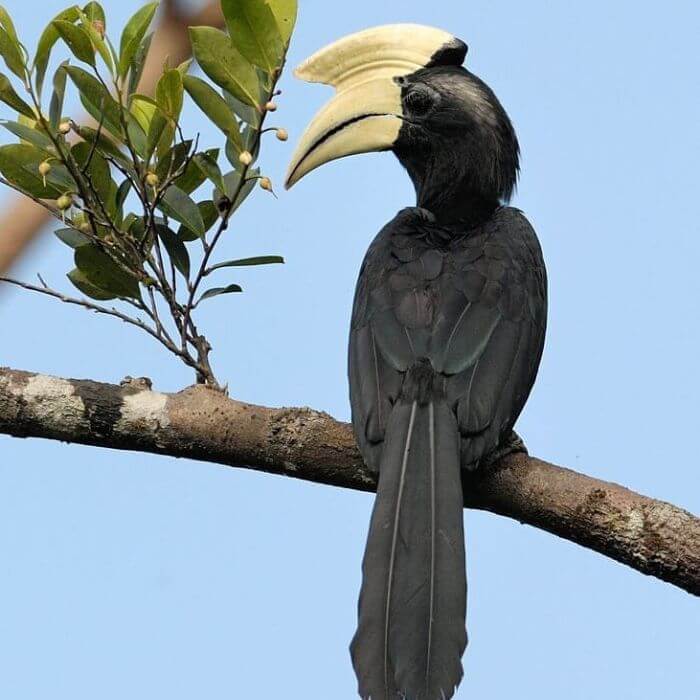
source: melinagoldenbird
Size:
With a large heavy bill, the black hornbill is a 23.6 – 25.6-inch bird that is a member of the hornbill family. Its scientific name is Anthracoceros malayanus.
Plumage:
Sooty black with a thick white eyebrow and white patch on tail. Males have a large white bill while females spot darker beaks.
Habitat & facts:
Black hornbills are found in forests across tropical Asia.They often form monogamous pairs and mate for life.
Also their breeding habits are unique. They are known to pick the largest trees and prefer forests with lots of durian fruit. Some black hornbills are known to avoid nesting for years in the absence of the fruit.
The female lays two to four eggs in a tree cavity, and both parents help to incubate them. The chicks stay with the parents for some time, learning how to find food and build nests.
14. Yellow-rumped cacique
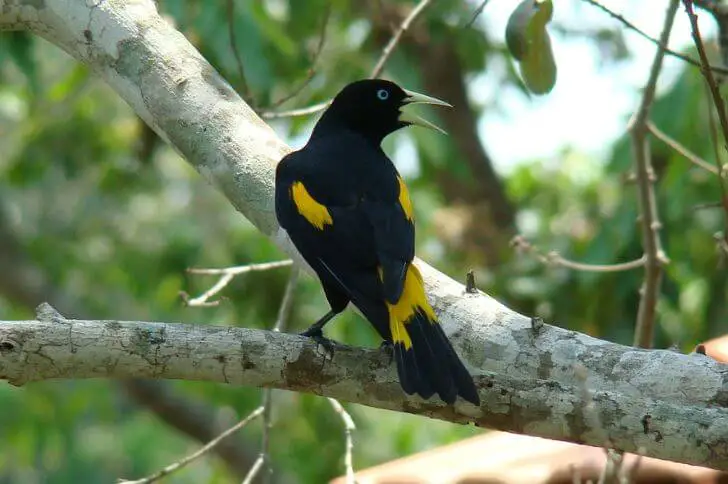
Size:
At about 11 inches long and weighing up to 3.7 oz, the Yellow-rumped cacique is a medium size bird that is easy to spot.
Plumage:
Be on the lookout for a black bird with yellow patches on the wings and rump. Note the blue eyes, white bill, and black feet. This cacique bird is very slim with a long tail. Juveniles are darker with dull eyes.
Habitat & facts:
Yellow-rumped cacique is a passerine bird in the New World family Icteridae. It breeds in South America, mostly central Brazil. It has a characteristic “jerky” flight.
The male’s song is a loud, high-pitched series of tinkling notes. The female builds a bulky stick nest in a tree and lays two or three white eggs. This black bird with white beak is found in open woodland. It feeds on insects and fruit.
15. Black butcherbird
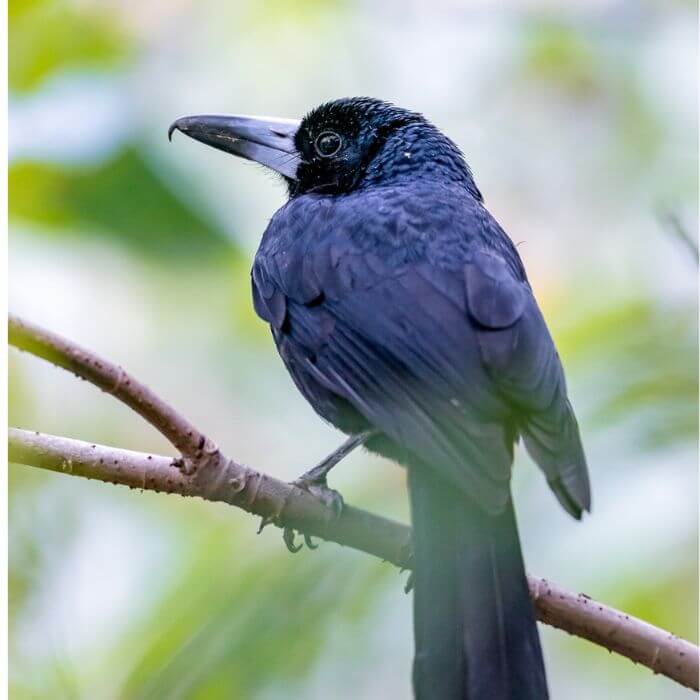
source: _peterrowland
Size:
Medium-sized and loud, black butcherbirds are about 12 – 16 inches in length.
Plumage:
All black with a white black-tipped bill. Young ones are a juvenile brown.
Habitat & facts:
The black butcherbird is a common Australian bird that is easily identified by its black plumage. They often congregate in large flocks where they forage for food. Black butcherbirds are known for their loud and distinctive calls, which can be heard from quite a distance.
Hi, my name is Steve. My friend and I started the spanishbirdguides.com to share our passion with other like-minded people. So, if bird watching is your thing, you’ll love this blog. I’ll share what I’ve learnt about both local birds and those found in other parts of the world. Also, I’d love to hear your experiences.
